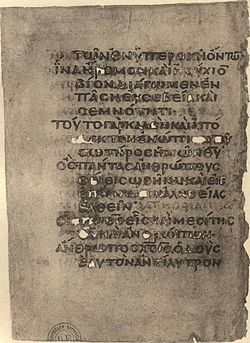

| 1 Timothy 2 | |
|---|---|
 Fragments showing 1 Timothy 2:2–6 on Codex Coislinianus, from ca. AD 550. | |
| Book | First Epistle to Timothy |
| Category | Pauline epistles |
| Christian Bible part | New Testament |
| Order in the Christian part | 15 |
1 Timothy 2 is the second chapter of the First Epistle to Timothy in the New Testament of the Christian Bible. The author has been traditionally identified as Paul the Apostle since as early as AD 180,[1][2][3] although most modern scholars consider the letter pseudepigraphical,[4] perhaps written as late as the first half of the second century AD.[5]
This chapter refers to prayer (verses 1 to 7, also in verse 8) and to the behaviour of women (verses 8 to 15).[6]
The original text was written in Koine Greek. This chapter is divided into 15 verses.
Some early manuscripts containing the text of this chapter are:
Clare Drury reads this verse as meaning that prayer is to be "the first duty of a member of the community". Although four words, "supplication", "prayer", "intercession", and "thanksgiving", are used, "no distinction is made between them".[6]
Chapter 3 opens with the words This is a faithful saying,[16] The saying is sure, or The saying is commonly accepted.[17] The words may refer back to the latter part of this chapter, including this verse, or they may be read as introductory to the material in chapter 3 about the office of a bishop.[6]